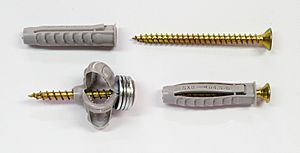Wall plug facts for kids
A wall plug is a clever little tool that helps you hang things on walls. You might also hear it called a screw anchor, especially in the United States. It's designed to give a screw something strong to grip onto, making sure your pictures, shelves, or other items stay firmly in place.
Contents
Wall Plugs: Holding Things Securely
Wall plugs are super useful for anyone who wants to attach something to a wall. Imagine trying to put a screw into a soft material like drywall. It would just pull right out! Wall plugs solve this problem by creating a strong, stable spot for the screw. They are a key part of many home improvement projects.
What Are Wall Plugs?
A wall plug is usually a small piece of plastic or metal. It has a hollow center where a screw goes. The outside of the plug often has ridges or wings. These features help it grip the inside of a hole you drill in the wall. When you put a screw into the plug, the plug expands. This expansion pushes against the wall material, creating a tight fit.
Why Do We Use Them?
We use wall plugs because many common wall materials, like plasterboard or drywall, are too soft to hold a screw on their own. If you just screw into drywall, the screw can easily become loose or pull out. This is especially true if you are hanging something heavy. Wall plugs spread the weight and pressure over a larger area. This makes the connection much stronger and more secure.
How Do Wall Plugs Work?
The magic of a wall plug happens when you insert a screw into it. First, you drill a hole in the wall that is just the right size for the plug. Then, you push the plug into this hole. When you start turning the screw into the plug, the screw's threads cause the plug to expand. This expansion creates a tight grip against the inside of the wall. It's like the plug is hugging the wall from the inside, holding the screw firmly.
Different Kinds of Wall Plugs
There are many types of wall plugs, each designed for different wall materials and different weights. Choosing the right plug is important for a strong hold.
Plastic Wall Plugs
These are the most common type. They are usually made from nylon or other strong plastics. Plastic plugs are great for lighter items like pictures, small shelves, or curtain rods. They work well in solid walls like brick or concrete, and also in softer materials like drywall, if they are designed for it.
Metal Wall Plugs
Metal wall plugs are often used for heavier items. They can be made from zinc alloy or steel. Some metal plugs have special designs, like those that expand into a "molly bolt" shape behind the wall. These are very strong and are often used for things like televisions or large cabinets.
Plugs for Different Walls
- Solid Walls: For brick, concrete, or stone, you usually use a simple plastic plug. The plug expands and grips the solid material.
- Hollow Walls: For drywall, plasterboard, or hollow block, you need special plugs. These plugs are designed to expand or create a knot behind the wall. This gives them a strong anchor point even in an empty space. Examples include toggle bolts or self-drilling drywall anchors.
How to Use a Wall Plug
Using a wall plug is a simple process, but it requires a few steps:
- Step 1: Choose the Right Plug and Screw. Make sure the plug is suitable for your wall type and the weight of the item. The screw should be the correct length and thickness for the plug.
- Step 2: Drill the Hole. Use a drill bit that matches the size of the wall plug. Drill a hole in the wall at the spot where you want to hang your item. Make sure the hole is deep enough for the entire plug.
- Step 3: Insert the Plug. Gently push the wall plug into the drilled hole. If it's a bit tight, you can tap it lightly with a hammer until it's flush with the wall surface.
- Step 4: Insert the Screw. Place your item over the plug and then drive the screw into the plug. As you turn the screw, the plug will expand and grip the wall. Stop screwing when the item is secure and the screw is tight.
See also
 In Spanish: Taco (construcción) para niños
In Spanish: Taco (construcción) para niños
Images for kids




